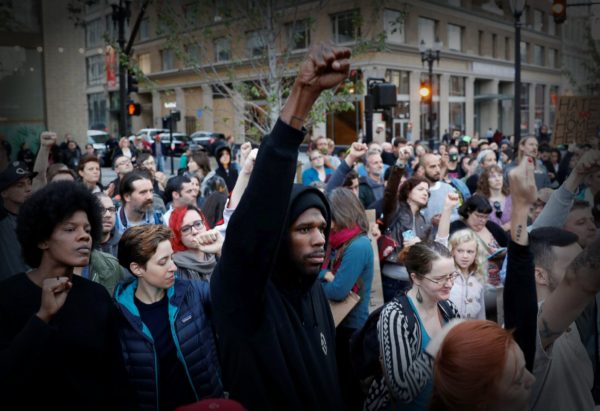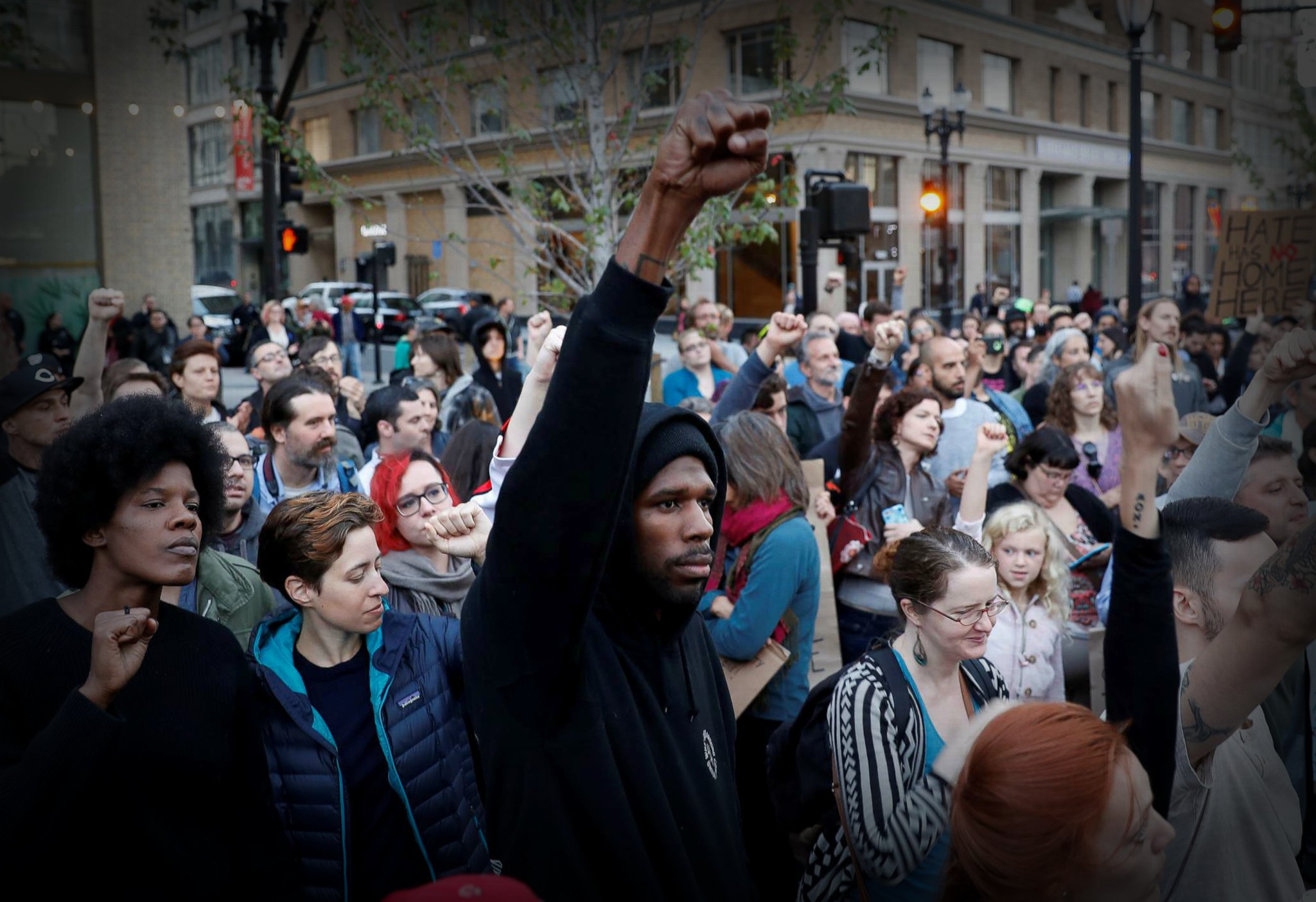
Photo: Stephen Lam/Reuters
The recent clash in Charlottesville, VA renewed media interest in the rise of far-right white supremacist groups and their ties to the President. The gathering of overt white supremacists is driven by what they perceive as the destruction of white culture and society in the US. Yes, most people look at a large gathering of torch-wielding men yelling “Jews will not replace us” and “Blood and Soil” and are rightfully repulsed. However, what isn’t addressed are the commonly held underlying beliefs that lead a person to the point of joining a klan rally:
- Disparities between ethnic groups in the United States are largely a result of personal (or group) failings rather than structural impediments caused by racism in society. [1]
- Moreover, any attempt to politically agitate against these barriers is playing identity politics and white people are allowed to have their own brand of identity politics. [2]
- Therefore, the incident in Charlottesville was caused by two sides so entrenched in their identity politics that it led to violence on both sides. [3]
But rather than address the claims of white supremacists with a list of cited refutations, this article is for those who think themselves to not be racist but are similarly concerned about PC (politically correct) run amok, Black Lives Matter (BLM), and other liberal protest movements.
Which brings us to our vendetta: identity v. colorblindness; how does the United States address identity-based inequalities when doing so causes other groups to feel as if their needs are being ignored? When I say identity, I mean advocacy for policy based on what you are, race, gender, sexuality, etc. Colorblindness, in this context, is the urge to make policy that does not take any of these in mind.
While debate rages over Confederate monuments and whether they should remain, that’s not what this article concerns. The monuments function more as a lightning rod for this vendetta because white supremacist/nationalist groups use it as cover to appeal to colorblind Americans for historical preservation and heritage purposes. On the other hand, minorities view these monuments as glorification of white supremacy, pointing out that they were largely built decades after the civil war at times when race became a political issue. [4] Often ignored in this conversation is the legacy of the policies and social phenomena that accompanied these waves of monument erections and their continued impact today. Though the list below is by no means exhaustive, I want to focus on these issues for now.
- Redlining/White Flight – Redlining was the official loan practice of the Federal Housing Administration that denied FHA mortgages to African Americans and other minorities from 1934-1968. [5] This precluded African Americans from owning homes or taking out loans to start businesses and build wealth. Exacerbated by redlining [6], white flight from neighborhoods with emerging black populations throughout the 20th century dropped inner-city property values and property tax-dependent schools in minority communities suffered. [7]
- Civil/Voting Rights Acts- Following the 1964 election in which anti-Civil Rights Act candidate Barry Goldwater won the South for Republicans for the first time [8]. The passage of the Voting Rights Act of 1965 and the Republican Southern Strategy [9] of using coded racial appeals to racist blue-collar white Americans to bring them to the Republican party, heralded the political realignment that we have today.
The policy of redlining meant that African Americans and other minorities would be left to rent in poor neighborhoods with poor schools in urban settings with little upward mobility. While it is true that housing deed restrictions prohibiting sale to African Americans were outlawed, and redlining has been prohibited, housing discrimination continues against minorities [10]. Today, anti-development groups in urban areas prevent new housing in largely white, high income communities; meaning that whiter and wealthier young people are able to buy out low income, largely black and brown communities compounding the housing crisis many cities face for minorities. Similarly, the Southern Strategy didn’t take African Americans from complete Republican support to Democratic support; African Americans were moving into the Democratic column prior to 1964 for economic reasons. The Republican embrace of the Southern Strategy, however, saw much of the remaining Republican support dry up.
Discriminatory housing and lack of voting and civil rights kept minority communities poor, disenfranchised, and white supremacy intact. Nowadays, the growth of suburban minority populations is still accompanied with white flight [11]. With the Supreme Court striking down of the pre-clearance section of the Voting Rights Act, states have made policies like gerrymandering [12] and Voter ID[13] that while doused in color blind rhetoric has the material effect of disenfranchising minority voters. These policies are some of what groups like Black Lives Matter are protesting, and the sight of minorities agitating for an equal opportunity is what animated the white supremacist groups to converge on Charlottesville, to “preserve and protect their history”. [14][15][16]
So what can we do?
If it seems I have come down decidedly on the side of identity, you’re not entirely wrong; policy that doesn’t take into account how people actually interact is extremely detrimental because it can be used to make things worse. However, that’s not the end of it; identity is important, it’s literally who we are, and how society sees you has a strong impact on your interactions with it. Likewise, the impulse to see others as no different from you comes from a good place. We should all strive to treat others based on their character and actions and not preconceived notions based on their identity. But that is different from policy. What needs to happen is that people of good faith have to come together and reject colorblind policy. Yes, it may be the case that Voter ID laws don’t name minority groups, but when the types of acceptable ID are more difficult to get when you’re black, there is effectively a racial barrier without an explicit one. Afterall, wouldn’t a specific a tax on yarmulkes be a tax on Jewish men? Sure, anyone can buy a yarmulke, but who is most likely to get one?
To this end, you the reader, can take steps to support the taking down policies that negatively impact other minorities. Seeing the colors that exist in the world does not mean you have to treat people differently based on their identity, it just means that you take it into account when creating policy that governs people of different colors. There is a lot to be done, but you can start locally. If you belong to a homeowner’s association, use your voice to advocate for more neighborhood housing and public transportation. If your state has onerous Voter ID laws, you can volunteer your time to help people obtain the necessary ID to register to vote; similarly, you can support legislation and initiatives that remove redistricting authority from state legislatures. These may be small steps to addressing a problem that has been with the country since before its founding, but if we’re ever going to get to a point where a person’s identity has no impact on their opportunity, we have to begin somewhere.
Housing Justice:
Voter ID Laws:
https://www.aclu.org/issues/voting-rights/fighting-voter-suppression/fighting-voter-id-requirements
http://www.voteriders.org/voter-id-clinics/
Ending Gerrymandering:
http://www.endgerrymandering.com/
http://reclaimtheamericandream.org/organizations-gerrymander/
- http://www.cnn.com/2017/08/16/politics/blacks-white-racism-united-states-polls/index.html
- https://fivethirtyeight.com/features/charlottesville-and-the-rise-of-white-identity-politics/
- https://twitter.com/DineshDSouza/status/896417842903560193
- https://www.splcenter.org/sites/default/files/whoseheritage-timeline150_years_of_iconography.jpg
- http://www.bostonfairhousing.org/timeline/1934-1968-FHA-Redlining.html
- https://www.theatlantic.com/business/archive/2014/05/the-racist-housing-policy-that-made-your-neighborhood/371439/
- https://pqdtopen.proquest.com/doc/851704622.html?FMT=ABS
- https://en.wikipedia.org/wiki/Southern_strategy#/media/File:ElectoralCollege1964.svg
- https://www.thenation.com/article/exclusive-lee-atwaters-infamous-1981-interview-southern-strategy/
- https://www.huduser.gov/portal/publications/fairhsg/hsg_discrimination_2012.html
- https://www.theatlantic.com/business/archive/2015/07/white-flight-alive-and-well/399980/
- http://www.nytimes.com/2013/02/03/opinion/sunday/the-great-gerrymander-of-2012.html?pagewanted=all
- https://www.theatlantic.com/politics/archive/2017/02/how-voter-id-laws-discriminate-study/517218/
- https://www.nytimes.com/2017/08/15/us/politics/trump-press-conference-charlottesville.html?mcubz=0
- https://twitter.com/realDonaldTrump/status/898169407213645824
- https://twitter.com/realDonaldTrump/status/898171544236687361




